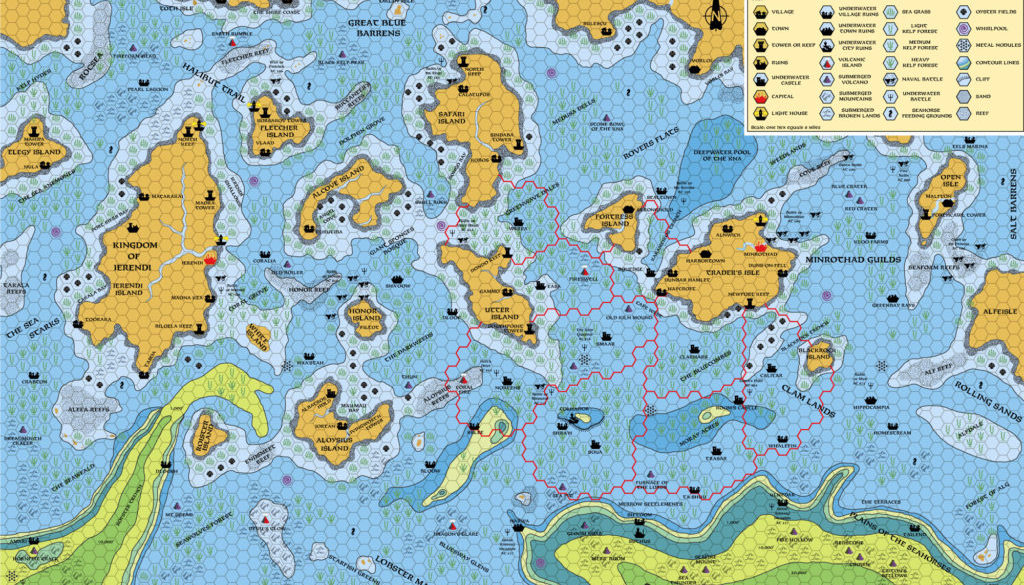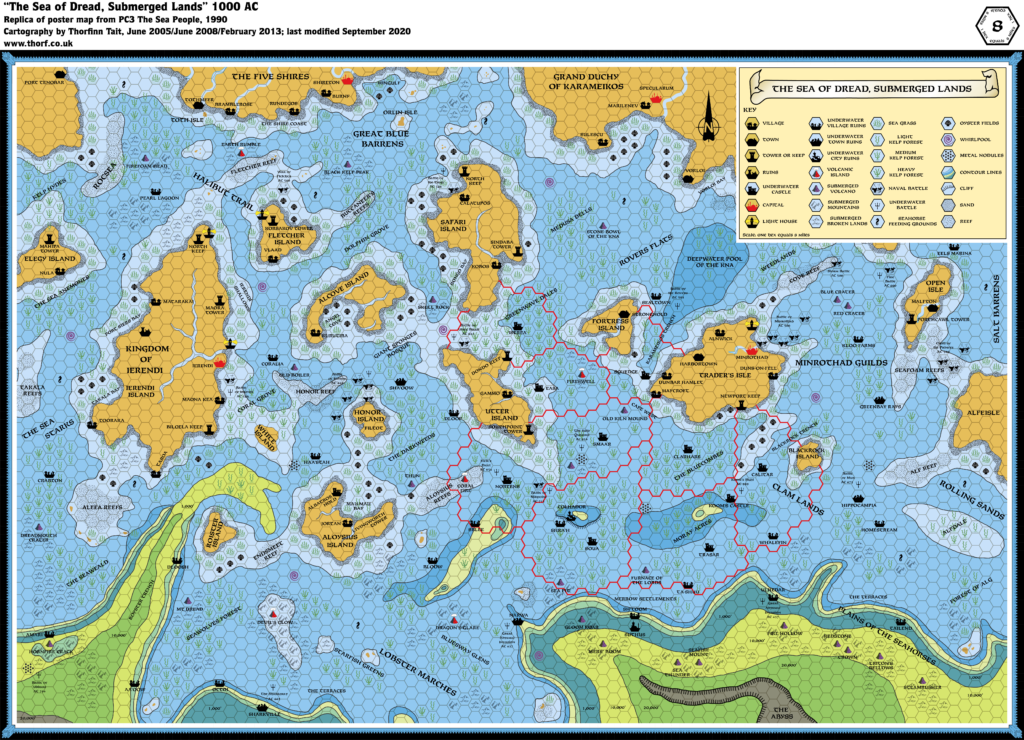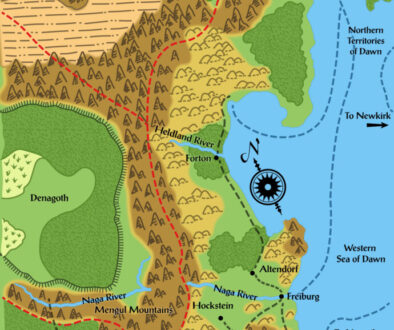PC3 Sea of Dread Submerged Lands, 8 miles per hex
The map that The Sea People presented was not the first underwater map produced for Mystara, but it was certainly the most detailed. Previously, X7 detailed the sea floor of the Sea of Dread, including this area, but at the smaller scale of 24 miles per hex.
PC3’s map took X7’s style and developed it into a full undersea mapping system, creating various types of terrain to detail underwater realms in a way that is clearly analogous to nations on land. As well as depth levels, there are mountains and hills to describe the roughness of the sea floor; whirlpools and volcanoes; kelp and sea grass forests; and of course underwater settlements of all kinds.
It’s a map marked by its sheer originality, giving as much life to the region below the waves as the surrounding lands. Unfortunately, this was the only official map created in this style, but the community later made up for this with further developments in undersea mapping.
Replica Map (September 2020)
Sources
- PC3 The Sea People (1990) (PDF at DriveThruRPG)
- Poster map (Cartography by Frey Graphics)
Map Types
The Atlas of Mystara includes a few fundamentally different types of maps. The colour of the castle wall border on each map shows which category it belongs to.
- Replica maps (white castle border) are exact replicas of primary source maps. They present the world of Mystara as the original source materials depict it, warts and all. No attempt has been made to fix errors of any kind — even typos. As far as possible, replica maps use the same art as the original maps, though in many cases they are colourised. These maps are the main source material of the Atlas of Mystara, forming the base of all of the updated maps.
- Updated maps (green castle border) present the Atlas of Mystara’s consistent view of the world, with all errors, alignment issues, and so on fixed. They use standardised hex art and fonts. Anything not marked as a replica map is an updated map.
- Chronological maps (yellow castle border) provide snapshots of Mystara at the end of a certain year in its publication history. In effect, they are updated maps created from a limited list of sources. The years in question appear in the title of each map.
- Fan-made maps are unofficial maps created by other fan cartographers. As such, they do not follow the Atlas’s castle border colour scheme. The Atlas presents these maps in their original form, with the permission of the cartographers. The Atlas considers these maps secondary sources, and updated maps of areas not covered by official maps make extensive use of them. In a few cases, the Atlas also presents Replica fan-made maps (red castle border).
Chronological Analysis
This is Map 128. It was published in 1990. The updated version of this map has not yet been released. See also Appendix C for annual chronological snapshots of the area. For the full context of this map in Mystara’s publication history, see the upcoming Let’s Map Mystara 1990.
The following lists are from the Let’s Map Mystara project. Additions are new features, introduced in this map. Revisions are changes to previously-introduced features. Hex Art & Fonts track design elements. Finally, Textual Additions are potential features found in the related text. In most cases, the Atlas adopts these textual additions into updated and chronological maps.
Analysis
PC3’s Sea of Dread Submerged Lands map is the most authoritative source we have on undersea contour lines (i.e. depths) in the Known World’s southern coastal area. Not only does the underwater map show more ranges of depth than any other map, but it also shows new details such as volcanic islands which can be placed on the above-water maps.
Coming Soon






17 January 2021 @ 9:37 am
This map has always been a favorite of mine. I’m curious as to other fan based ones and what they cover.
19 January 2021 @ 6:16 pm
The ones that I was thinking of were Hausman Santos’s 24 mile per hex map of the New Alphatian Sea, and John Calvin’s Sea of Dread maps. You can see Hausman’s at the Vaults of Pandius here, and John’s here. Both great maps.